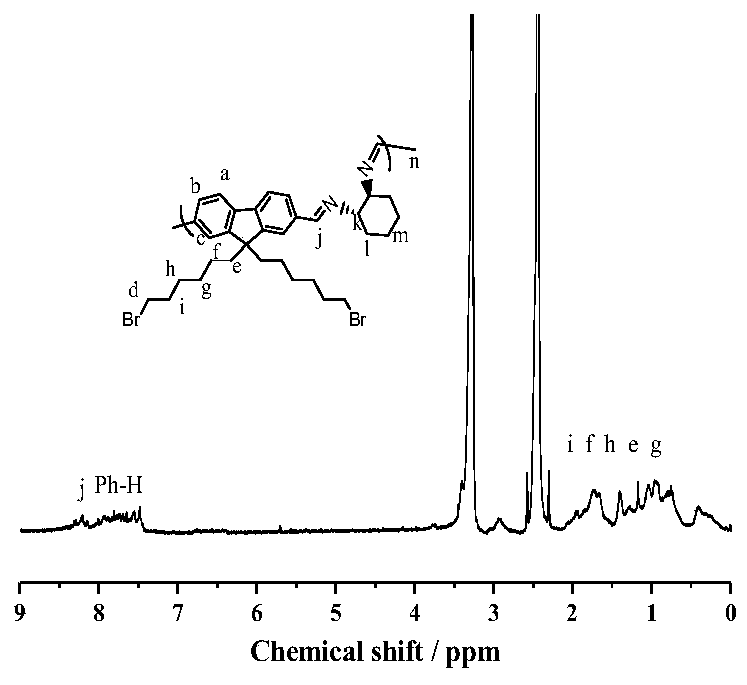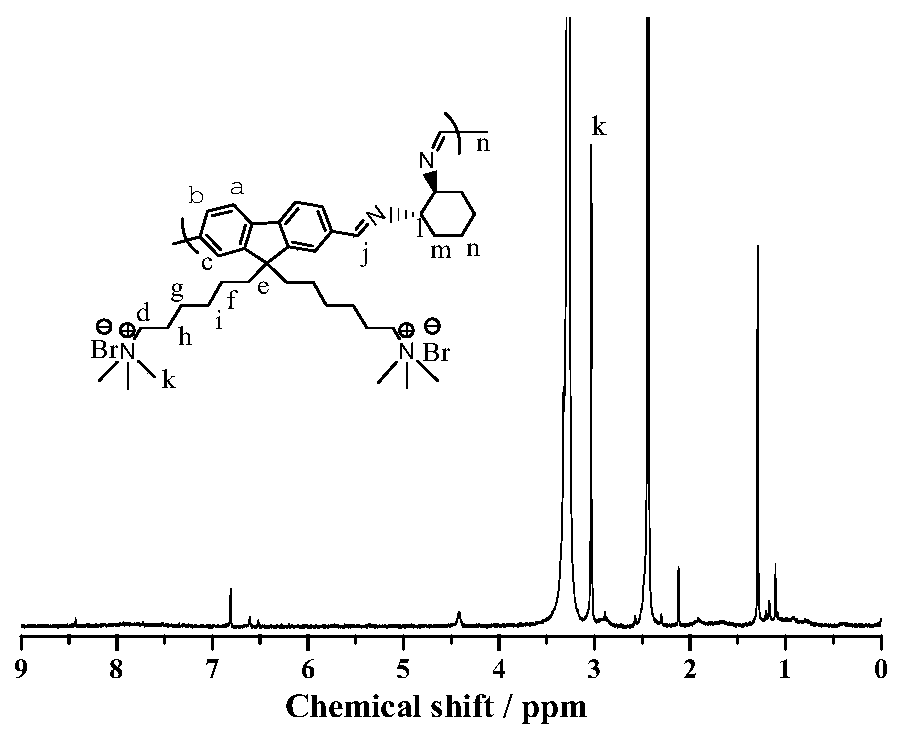Fluorenyl fluorescent polymer and preparation method thereof
A fluorescent polymer and polymer technology, applied in fluorescence/phosphorescence, chemical instruments and methods, luminescent materials, etc., can solve problems such as harsh test conditions, difficult operation, cumbersome process, etc., and achieve important application value and broad application prospects , the effect of accurate detection
- Summary
- Abstract
- Description
- Claims
- Application Information
AI Technical Summary
Problems solved by technology
Method used
Image
Examples
preparation example Construction
[0034] A preparation method route of the above-mentioned fluorenyl fluorescent polymer is as follows:
[0035]
[0036] 2. Preparation of a fluorenyl fluorescent polymer
[0037] The first step: firstly, compound I (9,9-bis(6-bromohexyl)-2,7-difluorenal) and (1S,2S)-cyclohexanediamine were used as raw materials, and the catalytic effect of anhydrous LiCl Polymer II was obtained.
[0038] In some specific embodiments: the molar ratio of the first reaction compound I to cyclohexanediamine is 1:1 to 1:3, the solvent used is dehydrated DMF, and the reaction condition is N 2 Environment, the reaction temperature environment is 100-120°C condensing and reflux, and the reaction time is 8-24h.
[0039] The second step: dissolving the obtained polymer II in a solvent, adding an aqueous solution of trimethylamine to obtain polymer III.
[0040] In some specific embodiment schemes: the solvent used for the reaction is a DMF solvent system, and the reaction conditions are N 2 envir...
Embodiment 1
[0047] Preparation of Fluorenyl Fluorescent Polymer III
[0048] Add 0.0193g (35μM) of polymer I (9,9-bis(6-bromohexyl)-2,7-difluorenaldehyde) into a 100mL reaction flask, according to the dialdehyde monomer and (1S,2S)- (+)-cyclohexanediamine monomer molar ratio is 1:2.5 for feeding, weigh 0.0125g (0.11mmoL) (1S,2S)-(+)-cyclohexanediamine, polymerization solvent is dehydrated DMF15mL, catalyst is 0.5g (0.0118moL) anhydrous LiCl, the reaction condition is N 2 Environment, temperature 110°C condensing reflux, time 12h.
[0049] After returning to room temperature, slowly add the reactant dropwise to 500mL of ice water to precipitate, centrifuge, dry, and finally wash with deionized water several times until the supernatant is clear, then vacuum-dry at 40°C for 12h to obtain 0.0145g of brown powder, namely As polymer II, the yield was 66%.
[0050] Such as figure 1As shown, the 1H NMR spectrum of polymer II is from low field to high field, and the peaks of various hydrogen p...
Embodiment 2
[0056] Fe 3+ detection method
[0057] We use the LS55 model fluorescence spectrophotometer to characterize and analyze the fluorescence properties of polymer III. The emission wavelength ranges from 330nm to 625nm, and the reaction temperature is room temperature. ex = 330nm.
[0058] Such as Figure 5 As shown, polymer III was dissolved in a buffer solution with a pH of 7 to make a sample solution with a concentration of 10 μmol / L, and then 0, 10, 20, 30, 40, 50, 60, 70, 80, 200, Fe with different concentrations of 400, 1000 and 1600μmol / L 3+ solution, and the different concentrations of Fe were explored by fluorescence spectrophotometer 3+ The effect of solution on the degree of fluorescence quenching of Polymer III. It can be seen from the figure that with Fe 3+ As the concentration increases, the fluorescence quenching effect of Polymer III is very obvious, when the Fe 3 + When the concentration increased to 1600μmol / L, the quenching percentage of polymer III was ...
PUM
 Login to View More
Login to View More Abstract
Description
Claims
Application Information
 Login to View More
Login to View More - R&D
- Intellectual Property
- Life Sciences
- Materials
- Tech Scout
- Unparalleled Data Quality
- Higher Quality Content
- 60% Fewer Hallucinations
Browse by: Latest US Patents, China's latest patents, Technical Efficacy Thesaurus, Application Domain, Technology Topic, Popular Technical Reports.
© 2025 PatSnap. All rights reserved.Legal|Privacy policy|Modern Slavery Act Transparency Statement|Sitemap|About US| Contact US: help@patsnap.com



